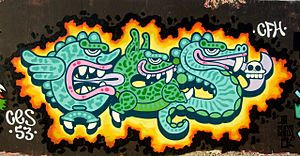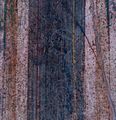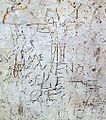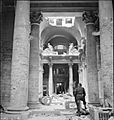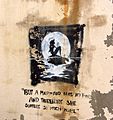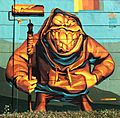Graffiti facts for kids
Graffiti means drawings, scribbles, or marks made on a public surface. It's often done with spray paint from a can. If there's only one mark, it's called a graffito. But usually, people use "graffiti" to talk about many marks.
Graffiti can be a form of art, drawings, or words. When someone makes graffiti without the owner's permission, it's seen as vandalism. Sometimes, it's just a person's name or a rude word. Other times, it's a public political protest. This is because making graffiti without permission is against the law.
Contents
The Long History of Graffiti
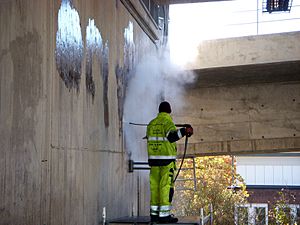
Graffiti is not new! People have been making marks on walls for a very long time. For example, in ancient Rome, people wrote messages and drew funny pictures called caricatures on walls.
You can find graffiti in many places around the world. Sometimes, artists create large murals of graffiti. These are big pictures that cover a whole wall. They can be very beautiful and are often made with permission. The simplest type of graffiti might be someone carving their lover's name into a tree with a knife.
Modern Graffiti and Its Styles
Today, much graffiti is a mix of writing and pictures. These designs can be very detailed and colorful. They are often made with spray paint on buildings, bridges, and street signs. Graffiti artists often sign their work with a special signature called a tag. This tag is like their unique symbol.
Graffiti is often linked to hip hop culture and street protests. It is usually illegal if done without permission. However, some cities have special areas where artists can create graffiti legally. Many people think graffiti can be a beautiful art form. Some even pay graffiti artists to decorate their buildings! In the 1980s, artists like Keith Haring became very famous for their graffiti-style art.
How Modern Graffiti Became Popular
Modern graffiti became well-known in New York City in the early 1970s. Young people from working-class families started it. They called their art "writing" and themselves "writers." In 1971, a newspaper article first used the word "graffiti" to describe this new art in New York City. This time, the early 1970s, is known as the "Original School" of graffiti. Later, in the 1980s, the next group of graffiti artists was called the "Old School."
Images for kids
-
Ancient Pompeii graffito caricature of a politician
-
Knitted graffiti in Seattle, Washington
-
Gang symbol markings on public property, Millwood, Washington
-
A bronze work by Jonesy on a wall in Brick Lane (London). Diameter about 8 cm.
-
Graffiti, Church of the Holy Sepulchre, Jerusalem
-
Viking mercenary graffiti at the Hagia Sophia in Istanbul, Turkey
-
Graffiti on the Mirror Wall, Sigiriya, Sri Lanka
-
Permanent engraving of Kilroy on the World War II Memorial in Washington, D.C.
-
New York City Subway trains were covered in graffiti (1973)
-
Graffiti on a wall in Čakovec, Croatia
-
Graffiti in Ho Chi Minh City, Vietnam
-
Graffiti art in Kuala Lumpur, Malaysia
-
Graffiti in Yogyakarta, Indonesia
-
Graffiti application at Eurofestival in Turku, Finland
-
Inscription in Pompeii lamenting a frustrated love, "Whoever loves, let him flourish, let him perish who knows not love, let him perish twice over whoever forbids love."
-
Graffiti as advertising in Haikou, Hainan Province, China, which is an extremely common form of graffiti seen throughout the country
-
Graffiti as legal advertising on a grocer's shop window in Warsaw, Poland
-
Graffiti in Buenos Aires, showing the Obelisk
-
Graffiti on a wall in Budapest
-
Graffiti on the wall of pedestrian tunnel in Tikkurila, Vantaa, Finland
See also
 In Spanish: Grafiti para niños
In Spanish: Grafiti para niños


